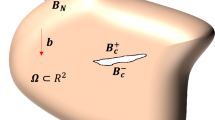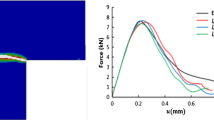Abstract
Finite element analysis is a popular method used to characterize crack tip stress and strain fields in fracture mechanics problems. In a constraint-based elastic-plastic fracture mechanics, the crack tip stress and strains are essentially dependent on the accurate crack tip finite element configuration. Typical finite element software does not provide control of node and elemental numbering order and sequence which caused difficulty to examine different crack configuration state of stress–strain using automated post-processing codes. A method to automate the creation of finite element mesh of arbitrary lengths and shapes of standard and nonstandard fracture mechanics geometries using a geometric progression technique is described. A list of equations was proposed to develop nodal and elemental model data that represented a defined region of a cracked geometry. Assembly of the regions produced a finite element mesh representing a fracture mechanics cracked geometry which can be incorporated into a typical finite element program. The approach can eliminate the modeling processes of finite element of cracked specimens and offers the ability to control the nodal and elemental numbering system to allow systematic stress and strain elucidation for large degrees of freedom mesh and history-dependent incremental plasticity crack tip analysis. The approach used to develop the finite element mesh was discussed, and examples of the finite element mesh generated by the approach were compared to established two-parameter elastic-plastic fracture mechanics results. Finally, the algorithm codes used to develop the cracked models are supplied as supplementary files to interested users.





















Similar content being viewed by others
References
T.L. Anderson, Fracture Mechanics: Fundamentals and Applications. (CRC Press, Boca Raton, 2005)
M. Kuna, Finite Elements in Fracture Mechanics: Theory-Numerics-Applications, in Solid Mechanics and Its Applications, vol 201, ed. by G.M.L. Gladwell (Springer, Wiesbaden, 2013)
S.H. Lo, Finite Element Mesh Generation. (CRC Press, Boca Raton, 2015)
J.C. Caendish, D.A. Field, W.H. Frey, An approach to automatic three-dimensional finite element mesh generation. Int. J. Numer. Methods Eng. 21(2), 329–347 (1985)
M.S. Shephard, Approaches to the automatic generation and control of finite element meshes. Appl. Mech. Rev. 41(4), 169–185 (1988)
R. Schneiders, R. Bünten, Automatic generation of hexahedral finite element meshes. Comput. Aided Geom. Des. 12(7), 693–707 (1995)
C. Geuzaine, J.F. Remacle, Gmsh: a 3-D finite element mesh generator with built-in pre-and post-processing facilities. Int. J. Numer. Methods Eng. 79(11), 1309–1331 (2009)
L.S. de Schiara, G.O. de Ribeiro, Finite element mesh generation for fracture mechanics in 3D coupled with Ansys: elliptical cracks and lack of fusion in nozzle welds. J. Braz. Soc. Mech. Sci. Eng. 38(1), 253–263 (2016)
J.C. Neto, P.A. Wawrzynek, M.T. Carvalho, L.F. Martha, A.R. Ingraffea, An algorithm for three-dimensional mesh generation for arbitrary regions with cracks. Eng. Comput. 17(1), 75–91 (2001)
C. Betegon, J.W. Hancock, Two-parameter characterization of elastic-plastic crack-tip fields. J. Appl. Mech. Trans. ASME. 58(1), 104–110 (1991)
N.P. O’Dowd, C.F. Shih, Family of crack-tip fields characterized by a triaxiality parameter—I. Structure of fields. J. Mech. Phys. Solids. 39(8), 989–1015 (1991)
S. Yang, Y.J. Chao, M.A. Sutton, Higher order asymptotic crack tip fields in a power law hardening material. Eng. Fract. Mech. 45(1), 1–20 (1993)
W.L. Guo, Elastoplastic three dimensional crack border field—I. Singular structure of the field. Eng. Fract. Mech. 46(1), 93–104 (1993)
F. Yusof, Three-dimensional assessments of crack tip constraint. Theoret. Appl. Fract. Mech. 101, 1–16 (2019)
H. Tada, P.C. Paris, G.R. Irwin, The Stress Analysis of Cracks Handbook (3rd Edition). (Det Research Corporation, Pennsylvania, 2000)
D.P. Rooke and D.J. Cartwright, Compendium of Stress Intensity Factors. (Procurement Executive, Ministry of Defence. H. M. S. O, 1976)
N.P. O’Dowd, Application of two parameter approaches in elastic plastic fracture mechanics. Eng. Fract. Mech. 52, 445–465 (1995)
W.L. Guo, C. She, J.H. Zhao, and B. Zhang. Advances in three-dimensional fracture mechanics. in Key Engineering Materials. (Trans Tech Publ, 2006)
ABAQUS, ABAQUS ver 6.12 User's Manual. 2012, Dassault Systemes, K. K.: Kaigan Minato-ku Tokyo, Japan
ANSYS, Academic Research Mechanical 18.1. 2019
ASTM-E1820, Standard Test Method for Measurement of Fracture Toughness. (ASTM, West Conshohocken, 2009)
MATLAB, 8.5.0.197613 (R2015a). (The MathWorks, Inc.: Natick, Massachusetts, United States, 2015)
R. Hill, The Mathematical Theory of Plasticity. (Clarendon Press, Oxford, 1950)
A. Sherry, C. France, M. Goldthorpe, Compendium of T-stress solutions for two and three dimensional cracked geometries. Fatigue Fract. Eng. Mater. Struct. 18(1), 141–155 (1995)
W.L. Guo, Elastoplastic three dimensional crack border field—III. Fracture parameters. Eng. Fract. Mech. 51(1), 51–71 (1995)
B. Zhang, W. Guo, Tz constraints of semi-elliptical surface cracks in elastic plates subjected to uniform tension loading. Int. J. Fract. 131(2), 173–187 (2005)
Acknowledgments
The authors would like to acknowledge the Ministry of Higher Education Malaysia (MOHE) grant (FRGS/1/2014/TK01/USM/02/5) which funded this research project. The ABAQUS finite element code that was used to perform the analysis was made available under an academic license from Dassault Systemes, K.K. Japan.
Author information
Authors and Affiliations
Corresponding author
Additional information
Publisher's Note
Springer Nature remains neutral with regard to jurisdictional claims in published maps and institutional affiliations.
Supplementary Information
Appendices
Appendix A: A flowchart for mesh creation implementable in a typical programming code

Appendix B: A crack tip mesh graphical user interface (GUI) program using Matlab supplementary file “gui_automate.m”

Rights and permissions
About this article
Cite this article
Leong, K.H., Yusof, F. & Latiff, R.H.A. Automatic Crack Tip Meshing Approach for Constraint-Based Fracture Mechanics Application. J Fail. Anal. and Preven. 21, 806–821 (2021). https://doi.org/10.1007/s11668-021-01119-5
Received:
Revised:
Accepted:
Published:
Issue Date:
DOI: https://doi.org/10.1007/s11668-021-01119-5




